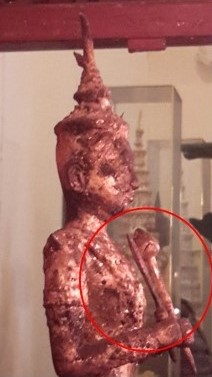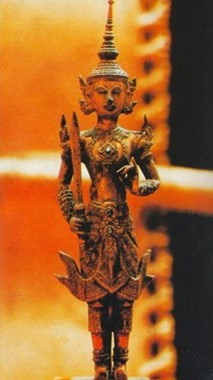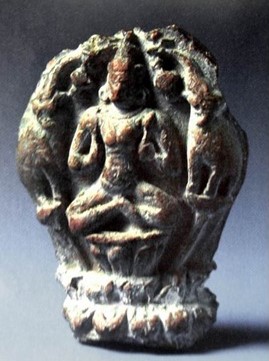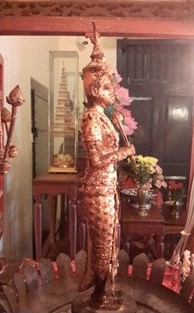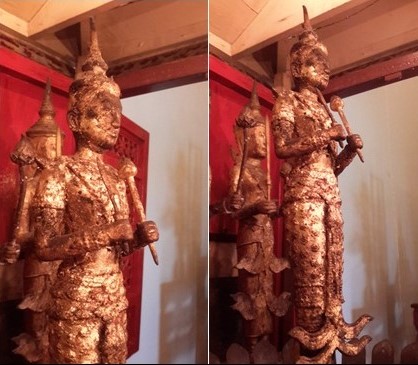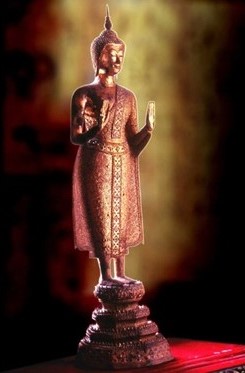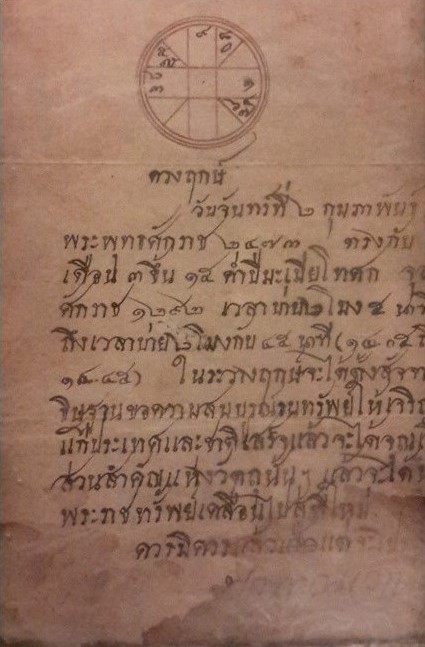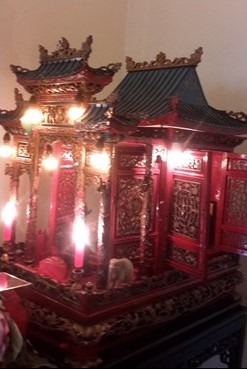The worshipping of deities and sacred spirits which reside in places has existed in Thai society for a very long time. This belief is expressed in creation of icons to symbolise the deities and in other objects of worship. An evidence of this includes religious icons made by the ancient elites or the ruling classes, such as Buddha figures, deity figures, or other figures of worship which were commissioned by kings, royal family members, or the nobles. They still persist until today.
The Thai court of Rattanakosin period also preserves the tradition of creating icons to represent deities and sacred spirits of worship. For example, in the period of King Chomklao or King Rama IV, a figure of Phra Siam Thevathirat was made and placed in Phaisan Thaksin throne hall in the inner court area of the Royal Palace in order to represent the deity who keeps peace, protects, and shield the Kingdom of Siam from potential harm. This holy figure has been until now widely worshipped by Thais. There is another figure of worship, called Phra Khlang (the deity of the treasury) of the royal treasury, which is believed to be the spirit that guards the state’s property, treasury, as well as economy. This figure of worship is created to represent the deity that protects the land’s treasury, as an object of worship and a moral support for civil servants as well as officers working in the royal exchequer, so that they would serve honestly, virtuously and rightly.
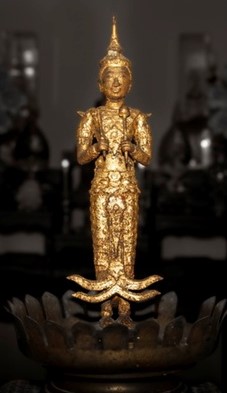
The Deity of the Treasury
The History of Phra Khlang of the Royal Treasury
The figure of Phra Khlang is located in the office building of the Bureau of Grand National Treasure of Thailand, on the outer area of the royal court in the Royal Palace. It is assumed that this building was previously the location of the national exchequer. The figure itself does not have a clear historical background. No documents have been found that mentioned the history of the figure. There is only an account that has been passed on by oral tradition, saying that the figure was made during the reign of King Rama V of Rattanakosin. The figure is generally called Phra Khlang, sometimes is called by the name ‘Chao Pho Khlang’. The present name of the figure is , Phra Khlang Nai Phra Khlang Mahasombat (the deity of the treasury of the royal treasury).
Iconographic characteristics of Phra Khlang of the Royal Treasury
Here we will discuss the iconography of the figure of Phra Khlang which reflects, through artistic features, the perspectives and beliefs the makers of the figure might have held at the time of making.
Iconography refers to the study and interpretation of religious symbols or religious beliefs through art. Therefore, the iconography of Phra Khlang of the Royal Treasury is to analyse and interpret the symbols and characteristics of the figure along with their context in order to better understand the message and the beliefs that the craftsmen from that period might have wanted to convey. Said significant iconographical characteristics are:
1. The Sculpture of Phra Khlang A buoyant sculpture, made of gold-plated bronze. It is approximately 12 inches or 32 centimetres of height. The figure is in a standing position, wearing princely clothes and a headpiece that resembles a crown. Its face is of oval shape, bearing a slight smile. There are many accessories decorating the figure, including a fabric neckpiece, a body chain, a chest piece, and a bracelet on both arms, a waistband, and a girdle. On the bottom, the figure was made to wear an embroidered robe decorated with front and side cloth, and curly-toed shoes. It stands on a lotus pedestal supported by an open tray decorated with lotus petals. There is a remark that the clothing of Phra Khlang resembles that of the kind of Buddha figures which was popular in Rattanakosin period. It can be said that the clothing of Phra Khlang is to portray the divine status of Phra Khlang according to Thai beliefs, in the same manner as Buddhist figures that were made in Rattanakosin period held. Three iconographical characters can be discussed as the following:
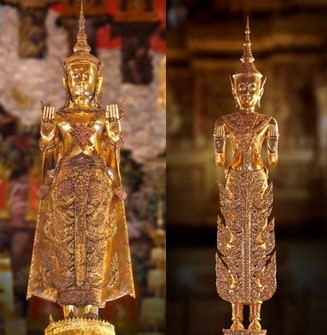
Fully-clothed Buddha figures of Rattanakosin Period
(Right) Fully-clothed Buddha figures during the reign of King Rama I in Emerald Buddha Temple
(Left) Fully-clothed Buddha figures during the reign of King Rama V in Thepsirin Temple
The objects in the hands of the figure of Phra Khlang bear clear meanings and implication regarding the status and role of the deity. The sword in the figure’s right hand represents the role as a guardian, just as Phra Siam Thevathirat. The lotus flower on the left represents fertility or wealth. The style of a deity figure holding a lotus flower was due to an influence of Brahminism/Hinduism from the ancient period. Such influence arrived in Thailand during Dvaravati period around 11-12th Buddhist Century Era. An archaeological item from Dvaravati period, a figure of Lakshmi, which was found to be holding a lotus flower in one hand also represents fertility. It can be inferred from this that the artistic style of holding a lotus flower in the case of Phra Khlang might bear the same meaning. This character has remained influential also in Rattanakosin period.
Objects in the hands of the figure of Phra Khlang (Right: Sword, Left: Lotus)
Phra Siam Thevathirat
A figure of Lakshmi from Dvaravati period (6-11 AD) holds a lotus flower in one hand to represent fertility.
The posture of Phra Khlang resembles that of Phra Siam Thevathirat. Phra Khlang was positioned to be standing straight on a brass tray that is made to have a clean-cut brim adorned by lotus petal decoration. The posture of the figure represents strength and a stable guarding position. The lotus-petal-shaped tray portrays a lotus flower which represents fertility. The entire composition is to represent a stable and strong economic wealth.
The posture of Phra Khlang, be standing straight on a brass tray with a clean-cut brim adorned by lotus petal decoration
Phra Khlang figure is made to be wearing an outfit that is similar to the style of traditional Thai deity. Accessories include a necklace, a body chain, arm bands, curly-toed shoes, and a robe. Like that of Phra Siam Thevathirat, this style is to represent wealth and princeliness. However, Phra Khlang wears a robe similar to the robe on fully-clothed Buddha figures of Rattanakosin Period; while Phra Siam Thevathirat’s robe was made into a pair of trouser. It is of notice that the fabric detail of Phra Khlang’s robe which is an embroidered floral pattern is similar to what is commonly found on the Buddha figures during this period of Rattanakosin era.
Phra Khlang figure is made to be wearing an outfit that is similar to the style of traditional Thai deity
Fully-clothed Buddha figures of Rattanakosin Period wear a robe with an embroidered floral pattern
The aforementioned characters of Phra Khlang shows that the sculpture was made to take the role of a guardian, just as Phra Siam Thevathirat. However, the two were made to differ in some details in order to reflect different guarding roles, i.e. Phra Siam Thevathirat is believed to be the guardian of the country, while Phra Khlang of the Royal Treasury is to protect the country’s treasury.
2. Seven-headed Naga The figure was made as a servant or a vehicle of Phra Khlang, in the same manner that Hindu gods have animal servant or vehicle. It is a sculpture of a seven headed Naga with an open hood on each head. On each face is an engraving of a traditional design of Chan flower; the body is coiled into three layers; the skin was carved into scale pattern. The figure is placed on a brass tray with the same lotus petal decoration as the tray that supports the figure of Phra Khlang. According to the belief that Naga is an animal that brings water, it is thus regarded to represent fertility. Furthermore, as a big snake, it is also believed to take up a role of a guardian of treasure. According to ancient beliefs, Naga is the animal that guard valuables in important places. Such beliefs are in accord, and relate well with the role of Phra Khlang. Therefore, it is likely that the Naga sculpture is regarded as a guardian animal as well as a vehicle of Phra Khlang
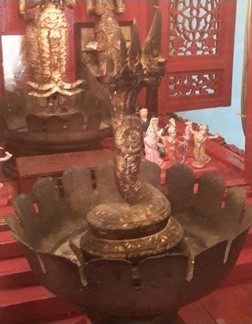
Seven-headed Naga, a servant or a vehicle of Phra Khlang
Wooden figures of Phra Khlang
3. Wooden deity figures They are carved wooden sculptures placed behind the figure of Phra Khlang; there are three in total. No evidence has been found regarding the purpose of the creation of the three. All bear the same composition as the figure of Phra Khlang. They differ only in the detail of the carvings. There are two assumptions regarding the three deity sculptures as the following:
1. They might have been replicas of Phra Khlang sculpture, made and given as an offering in different occasions. They might have been commissioned by noblemen or the civil servants who took office within the treasury department for the purpose of good luck and raising morale. The three sculptures seem like a replica to Phra Khlang sculpture; the only different is the material used. Additionally, the posture of the three figures and the objects they are holding are the same as that of Phra Khlang; in other words they are also to represent the role of guarding the nation’s treasure as well as ordaining wealth and fertility in the nation.
2. They might have been draft models before the actual sculpture of Phra Khlang, which is located in the middle, was made. The carvings on the three wooden figures are quite rough as well as different from one another. Therefore, it is likely that the three were drafts that were made during the same period, before the making of the actual figure of Phra Khlang was made.
4. Inscription of traditional horoscope chart Written in Thai, they are placed at the back of the three wooden figures. These include a bronze plaque inscribed with a horoscope chart and another inscription made of paper. On the bronze plaque the name of the department of the treasury was clearly inscribed. The inscription also includes the auspicious time and date of an important ceremony. It says "the Department of the Treasury, 2 February 2473 BCE, time 14.05, 3rd waxing moon day, the year of the horse, year 1292 according to Lunisolar year calendar, 2 o’clock in the afternoon and five minutes, zodiac sign: Gemini.”
The paper inscription was handwritten, and framed in a glass frame. The content of the paper inscription includes the same auspicious time and date as on the bronze plate. It says as the following: "The time at Monday 2nd February 2473 BCE, time 14.05, 3rd waxing moon day, the year of the horse, year 1292 according to Lunisolar year calendar, from two o’clock and five minutes in the afternoon to two o’clock and forty-five minutes (14.05 to 14.45). At this time, may [we] make a pray for more growth in the wealth of the country. When this is accomplished, an important objective will also be fulfilled. Then, the royal wealth will be transferred to a new place. [This] depends upon your mercy.”
Both documents clearly show the same horoscope, time, date and year. They are an auspicious time for transferring wealth to a new location. These inscriptions might bear some relation with the figure of Phra Khlang. This issue must be investigated further.

A bronze plaque inscribed with a horoscope chart
An inscription made of paper
5. Chinese Pavilion This is the location of where Phra Khlang of the royal treasury is being placed. It is a small Chinese pavilian made with red-painted wood carved in Chinese style. The door is composed with wooden partitions that can be folded open. The style is in accord with that of divine residence for Chinese deities. From this, the Chinese influence is clear. This pavilion as the residence of Phra Khlang is likely meant to refer to the royal treasury. The decoration of the pavilion has auspicious meaning according to Chinese beliefs. For example, over the door frame in the front is a carved image of San Xing the three deities, which represent prosperity, status, and longevity. The image is of a rectangular shape that is placed over the front door of the pavilion, and is supposed to bring happiness and success according to the conveyed meanings.
Chinese Pavilion
The decoration of the Chinese pavilion
There are also other decorations that bear good meanings. For example, the carved image of a dragon around the pillars at the front facade represents the power to expel evil and the power of protection. The balcony was carved with a Chinese-style pattern, containing fruits and flowers that have auspicious meanings such as plum, clusters of grapes, peony flowers. All represents fertility, wealth, good luck, and the power to expel evil. Additionally, doorframes and window frames are carved with patterns that represent affluence, namely connected traditional Thai floral design, plum fruits, plum flowers, and peony flowers. These patterns reflect Chinese influence that is still exists in Thai belief system until today.
Phra Khlang of the Royal Treasury is a sculpture of worship whereby no clear evidence has been found to explain its creation. It is believed to be the deity who guards national treasure and the treasury itself. The iconography of the sculpture is a clear indication to its role and duty. It is considered the sculpture that, with the good meanings attached to it, supports the morale of civil servants and officers who serves in finance and in the treasury. Auspicious symbols were added to give blessings to public worshippers; however the underlying intention is to urge the officers of the treasury to serve honestly. In conclusion, the sculpture of Phra Khlang of the Royal Treasury is a very interesting item, many issues of which are subject to further study.



